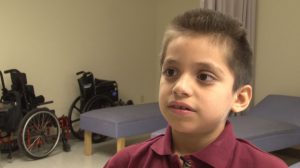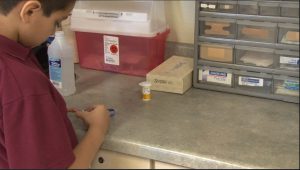- Slug: School nurses. 700 words.
- Photos available (thumbnails and captions below)
- Video story available
By NATALIE TARANGIOLI
Cronkite News
PHOENIX – School nurses do more than bandage scraped knees – they often provide a lifeline to student’s medical care for a chronic condition like asthma or diabetes, advocates say.
A national pediatrician’s group recommends every school have a nurse, but Arizona does not require that standard. That means inconsistency among district schools and charters, where some districts like Mesa Public Schools, Gilbert Public Schools and Cartwright School District in Maryvale have at least one nurse per school and others are stretched thin.
The June policy statement “calls for a minimum of one full-time registered nurse in every school” from the American Academy of Pediatrics.
The Centers for Disease Control and Prevention say only about half of schools in the country have nurses assigned, but data about the number of Arizona school nurses is difficult to find. One reason is school nurses aren’t required under state law.
Another reason is a school nurse isn’t clearly defined. Sometimes a school nurse isn’t a licensed nurse, said Nadine Miller, president of the School Nurse Organization of Arizona and director of health services for Mesa Public Schools.
“When you go to your school, and you say, ‘Do you have a school nurse?’ Most places tell you ‘yes,’ ” Miller said. “Oftentimes, that person in that health office is a medical assistant, a secretary, a nice mom that’s come to help, but it’s not always a nurse.”
Schools without nurses can be a loss for students, she said.
More than half of children in Arizona are considered low-income, according to the National Center for Children in Poverty. School nurses can treat children when a trip to the doctor isn’t a financial option.
Cartwright School District has a nurse in each of their 21 schools, which follows the pediatric group’s recommendation.
Judy Evans, nursing coordinator for the district, said many families are thankful their children have someone at school who can treat them as needed.
“They rely on school nurses for so much,” Evans said. “A lot of them do not have their own private physician or pediatrician. They just don’t think they have anywhere else to take them – and sometimes they don’t.”
Evans said each Cartwright district-school nurse will see from 50 to 100 students each school day. Some have more chronic conditions that need to be seen regularly, like third-grader Angel Rengel.
Rengel has Type I diabetes and sees the nurse at Starlight Park Elementary at least twice a day to help him with his insulin shots. Without the school nurse, the seven-year-old most likely wouldn’t be able to be in class.
“I’d have to go back to the doctor, and usually stay there,” Rengel said.
School nurses also can prevent absenteeism, according to the National Association of School Nurses. Schools with a full-time nurse have about half the student illness- or injury-related early releases from school compared to schools with no nurses, the association website said.
Charles Tack, communications director for the Arizona Department of Education said even though school nurses are not required in the state they are important to education.
“It can help student achievement, it can help make sure students are healthy,” Tack said. “We know that students need to be healthy in order to learn.”
Miller said she recognizes the need for more nurses in schools but budgets sometimes can’t be stretched to cover the cost of staffing a nurse.
“School budgets, particularly in Arizona right now, have not been very good,” Miller said. “School nursing is not always on the forefront, because you need a teacher in that classroom first and foremost.”
Tack said it’s on the shoulders of local school boards to assess their community’s needs and allot funding for a school nurse.
“Those local school districts, they do have that ability: to bring in the parents, to bring in the families and the community members and find out what the needs are,” Tack said. “Then they can put those policies into action that best serve their communities and families.”
Leaders at the Cartwright district recognized parents wanted to make school nurses a priority.
“We really have a good rapport with the parents,” Evans said. “So they are very happy when they do see a school nurse here.”
^__=


